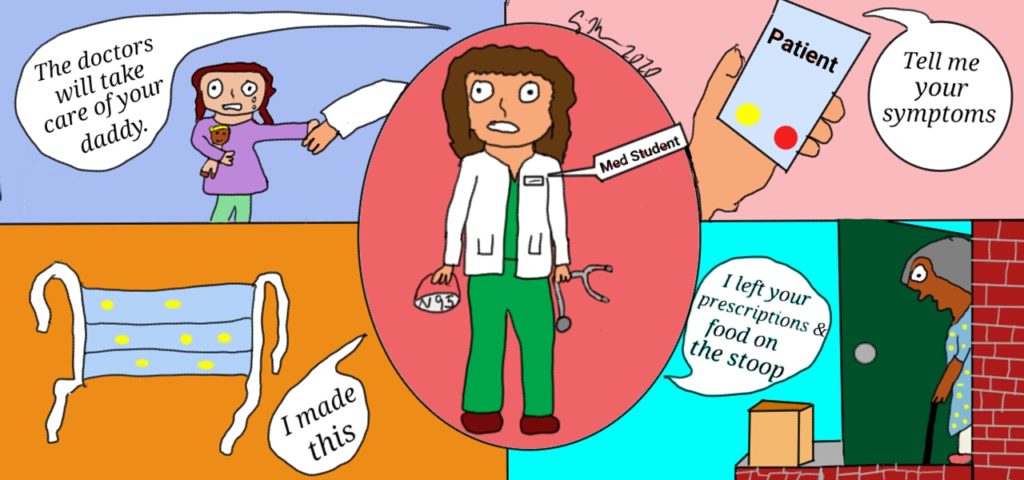by Amal Cheema
“When pestilence prevails, it is [a physician’s] duty to face the danger, and to continue their labors for the alleviation of suffering, even at the jeopardy of their own lives.” Baker, R., A. Caplan et al. 1999
The COVID-19 pandemic has changed the course and experience of medical training for thousands of students. Many, if not all, medical schools have moved classes entirely online, postponing anatomy labs and clinical skills classes. Heeding the guidance of the Association of American Medical Colleges, allopathic schools have canceled all rotations. Our professors, mentors, and healthcare professionals are at the frontlines, serving their communities and defending against a healthcare system collapse.
Many of my peers and I are asking ourselves what our roles and responsibilities are in this pandemic. Are we medical professionals? Do we have responsibilities fundamental to the profession? During my white coat ceremony, our class recited a mission statement, derived from the values we articulated. In front of loved ones who enabled our journey, we recited, “We are bonded together in a common mission to serve others…As members of this medical profession that has earned the trust of so many, we will strive to continually cultivate our compassion for others, act as leaders in the communities we serve.” As Dr. Steven Kanter wrote in a 2010 open letter to new medical students, we become part of the profession when we identify and behave accordingly. Our professional identity does not magically form with the bestowal of an M.D., but when we, medical students, choose to believe that we are responsible for our communities.

Sketch22023140What then are our responsibilities in responding to the COVID-19 pandemic? Are they the same as that of our professors, mentors, and other medical professionals? Dr. Kanter’s letter provides a few answers. Intrinsic to the profession is an obligation to help. Using the analogy of a car accident, he urged new medical students to recognize their duty to help in whatever way they are qualified and to do no harm. Thus, what medical students have to offer during this pandemic is accordant to their qualifications and experiences.
Preclinical students have basic training in physical exam and clinical skills. At the early stages of our training and without prior experience, I am not sure if many of us have much to offer when it comes to patient interactions. However, we can assuredly help out in small ways with a significant impact. At a minimum, we can abide by public health measures and recommendations to socially distance ourselves, minimize our list of in-person contacts, and home quarantine. While we fall in an age bracket less threatened by COVID-19, young adults can still get sick enough to end up in the ICU, exacerbating the strain on the healthcare system. Regardless if we believe we are invincible, we can still spread the disease to others, even if asymptomatic or with mild symptoms.
Moreover, with due caution and safety, we can assist in community organizing efforts that emphasize non-contact modes of helping, such as delivering groceries to the elderly, connecting people with economic aid, and calling those afflicted by loneliness. We can also provide childcare to healthcare workers. Here is a Google document that is crowdsourcing ideas and documenting ways in which medical students are already helping COVID-19 responses, from infection control to patient management.
Medical students in their clinical years or those with more advanced training can help out in the aforementioned ways. They can also be potential assets in a patient-care setting. Italy has already graduated and activated 10,000 medical students to help in the pandemic. The U.K. is urging its medical schools to fast-track its students to the wards. Other countries like Germany are also exploring the role of medical student volunteers. In the U.S., Governor Cuomo of N.Y. has already inquired into the potential of medical students and faculty in helping manage the pandemic.
Discussing historical examples, a second-year student at my school wrote a powerful Op-Ed on ways medical students can contribute to the clinical setting. However, given the diminishing supplies of personal protective equipment (PPE), students should not occupy roles requiring PPE. Students lack licenses and clinical know-how to act independently; thus, having students work in situations requiring PPE will be inefficient resource allocation. Placing students in high-risk or uncertain situations without PPE will cause unacceptable harm. Instead, students with clinical training could provide help in ways that will not require PPE. They can care for patients without coronavirus, help monitor patients remotely, complete administrative tasks, and volunteer in ways that will alleviate the burden and workload faced by the healthcare system.
Given the bleak outlook and parallels being drawn between the U.S. and Italy’s crises, I wonder of only when students will be called upon to help support our healthcare system. Each medical school, governing bodies, and its students need to have pre-emptive, transparent, and non-paternalistic discussions that will determine the emergency activation threshold at which students or other medical reserves will become involved in pandemic efforts. Such a debate must weigh the benefits and harms of setting the limit too high or low. Medical schools and their students need to prepare themselves for those contingency plans. At all stages of our career, we must ask ourselves how our actions honor our professional obligation to serve patients and our communities.